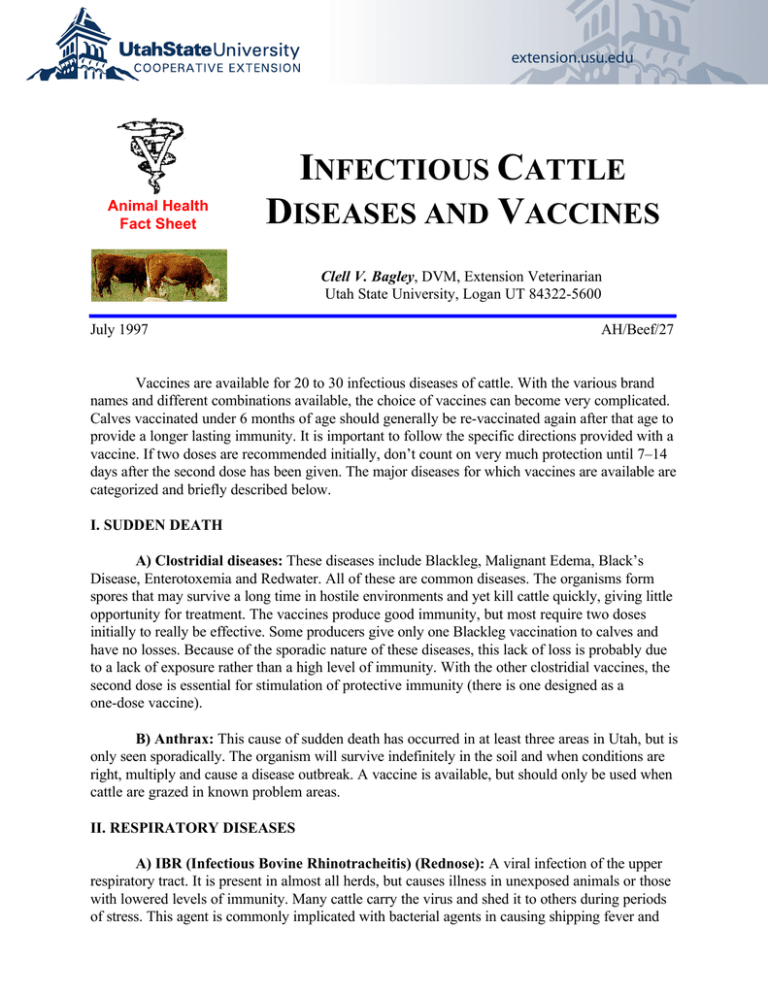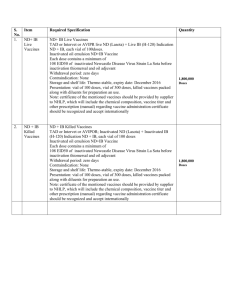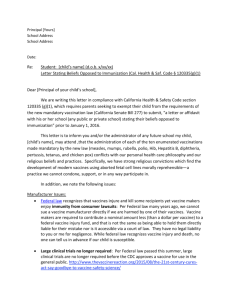I C D V
advertisement

extension.usu.edu Animal Health Fact Sheet INFECTIOUS CATTLE DISEASES AND VACCINES Clell V. Bagley, DVM, Extension Veterinarian Utah State University, Logan UT 84322-5600 July 1997 AH/Beef/27 Vaccines are available for 20 to 30 infectious diseases of cattle. With the various brand names and different combinations available, the choice of vaccines can become very complicated. Calves vaccinated under 6 months of age should generally be re-vaccinated again after that age to provide a longer lasting immunity. It is important to follow the specific directions provided with a vaccine. If two doses are recommended initially, don’t count on very much protection until 7–14 days after the second dose has been given. The major diseases for which vaccines are available are categorized and briefly described below. I. SUDDEN DEATH A) Clostridial diseases: These diseases include Blackleg, Malignant Edema, Black’s Disease, Enterotoxemia and Redwater. All of these are common diseases. The organisms form spores that may survive a long time in hostile environments and yet kill cattle quickly, giving little opportunity for treatment. The vaccines produce good immunity, but most require two doses initially to really be effective. Some producers give only one Blackleg vaccination to calves and have no losses. Because of the sporadic nature of these diseases, this lack of loss is probably due to a lack of exposure rather than a high level of immunity. With the other clostridial vaccines, the second dose is essential for stimulation of protective immunity (there is one designed as a one-dose vaccine). B) Anthrax: This cause of sudden death has occurred in at least three areas in Utah, but is only seen sporadically. The organism will survive indefinitely in the soil and when conditions are right, multiply and cause a disease outbreak. A vaccine is available, but should only be used when cattle are grazed in known problem areas. II. RESPIRATORY DISEASES A) IBR (Infectious Bovine Rhinotracheitis) (Rednose): A viral infection of the upper respiratory tract. It is present in almost all herds, but causes illness in unexposed animals or those with lowered levels of immunity. Many cattle carry the virus and shed it to others during periods of stress. This agent is commonly implicated with bacterial agents in causing shipping fever and other severe cases of pneumonia. (See also Reproductive Diseases). Both MLV (modified live virus) vaccines and killed (or attenuated) products are available. Some are designed for IM (intramuscular) use while others are given IN (intranasally). The killed and intranasal products may be used in, or around, pregnant cows but other vaccines may cause abortions. The IN vaccines will cause some antibody response within three days and may be useful even in the face of an outbreak. Two doses of a killed product must be used to confer protective immunity. All replacement animals should be vaccinated. For intensively managed herds, annual boosters are recommended. B) PI3 (Parainfluenza-3): Another viral respiratory agent that causes a relatively mild disease by itself, but a severe problem when combined with a bacterial agent. It is included with most IBR vaccines and can be used on the same schedule. C) BVD (Bovine Virus Diarrhea): A common viral agent, present in almost all herds. It may cause respiratory, digestive tract or reproductive problems. It has a profound detrimental affect on the immune system. A number of MLV vaccines have been available. Killed vaccines are also available which stimulate a good immune response in adult animals. But, they are apparently not able to protect the fetus. Two doses are required initially. All replacement animals should be vaccinated with an MLV vaccine (perhaps even two doses), after 6 months of age and prior to breeding. (See also Reproductive Diseases). D) BRSV (Bovine Respiratory Syncytial Virus): A relatively recently recognized disease agent, but now identified all across the country in respiratory infections. It is mainly a problem in weaned and feedlot animals (also young dairy stock). Both MLV and killed virus vaccines are available with two initial doses required for both. E) Pasteurella: A bacteria carried by many normal cattle. It becomes a major cause of severe “shipping fever” pneumonia when combined with stress and a viral agent. Two species are common: P. hemolytica and P. multocida. Vaccines available in the past were poor, with use of a single dose causing more problems than if none were used. Great improvements have been made in recent years and several newer products are available, with more to come. Both one and two dose products are now available. Follow directions carefully for these products to be beneficial. They must usually be given prior to weaning in order to help hold down the occurrence of disease at this critical time. F) Haemophilus sommus: This agent is the other major bacterial agent involved in shipping fever. It also causes “brain fever” in feedlot cattle (also known as TEME: thromboembolic meningioencephalitis). The killed vaccine must be given in two doses initially and should be used prior to weaning for the greatest benefit. III. REPRODUCTIVE DISEASES A) IBR: The most common cause of abortion in cattle. All replacements should be vaccinated to protect against it (See Respiratory Diseases). Use the proper vaccine for, or around, pregnant cows. B) BVD: May cause early embryonic death, abortion or congenital defects. Vaccinate all replacement animals with a MLV vaccine (two doses preferred) to produce a planned exposure between 6 months of age and breeding. (See Respiratory Diseases). C) Brucellosis (Bangs): Many states are free of this disease agent, but vaccination is still recommended (and required for sale) until the threat from other states is further reduced. All heifers 4–12 months of age should be vaccinated by an accredited veterinarian. They must also be ear tagged and tattooed. Many states will not accept animals for breeding purposes unless the tattoo can be identified. D) Vibriosis (Campylobacter): A common bacterial disease, spread through breeding. It causes early embryonic death so appears as an infertility and results in a prolonged breeding and calving season as well as a reduced calf crop. Two types of vaccine are available. One is in an oil base product to prolong the absorption. Only one dose is required initially. Subsequent boosters given in the fall at pregnancy testing will extend the protection on through the next breeding season. The other type of vaccine has an aluminum hydroxide or other adjuvant and requires two doses initially. Be sure to give both doses to obtain a protective level of immunity. The annual boosters for this type of vaccine should be given 30 days prior to breeding. This type comes in combination with Lepto and other vaccines and is easier to administer, but it must be used according to directions if it is to be effective. Bulls infected with vibrio have been cleared by use of two doses (of 5 ml) of the oil base vaccine, 30 days apart. All bulls should be vaccinated and given an annual booster in the fall. All cows in multiple owner herds and in herds adding used cows or bulls should be vaccinated. E) Lepto: May cause abortion and illness. It has not been commonly diagnosed in Utah in recent years, but is very difficult to diagnose. It is spread through urine and water contamination so is a potential threat to almost all cattle. It may also be carried by other species including rodents, dogs, swine and man. F) Trichomoniasis: A common disease in Utah that causes early embryonic death. A vaccine is available with an efficacy of about 50%. It should be considered for use in infected herds which are mixed with other during the breeding season. Two doses are required initially. The second (and the annual booster) should be given 30 days prior to the beginning of breeding. IV. SCOURS A) Rota and Corona Virus: Two viral agents that are common in Utah herds and contribute to scours. They usually produce only mild disease signs by themselves, but become more severe when combined with stress or other agents. A vaccine is available for problem herds. It requires two doses the first year and the last dose should be given at least three weeks prior to the start of calving. It may be used in combination with E. coli. B) E. coli (Coliform): A bacterial cause of scours that usually appears in calves under 5 days of age. A common contaminant in manure and may build up to epidemic levels. A vaccine requiring one or two initial doses is available for the cows prior to calving. A monoclonal antibody product is also available for use on calves at birth (by mouth) if a serious outbreak occurs in calves from dams that have not been vaccinated. It will provide some immediate, but short term protection. V. PINKEYE An eye infection due to a specific bacteria, that is commonly carried by many normal cattle. A herd outbreak is often precipitated by eye irritation (dust, sunlight, etc.). The infection is readily spread to other animals by face flies. Several vaccines are now available. Since the immunity they stimulate is not very long-lasting, these vaccines should be administered in the spring just prior to the fly season. This will provide the greatest protection during summer, the period of greatest exposure. Utah State University Extension is an affirmative action/equal employment opportunity employer and educational organization. We offer our programs to persons regardless of race, color, national origin, sex, religion, age or disability. Issued in furtherance of Cooperative Extension work, Acts of May 8 and June 30, 1914, in cooperation with the U.S. Department of Agriculture, Robert L. Gilliland, Vice-President and Director, Cooperative Extension Service, Utah State University, Logan, Utah. (EP/DF/07-97)






